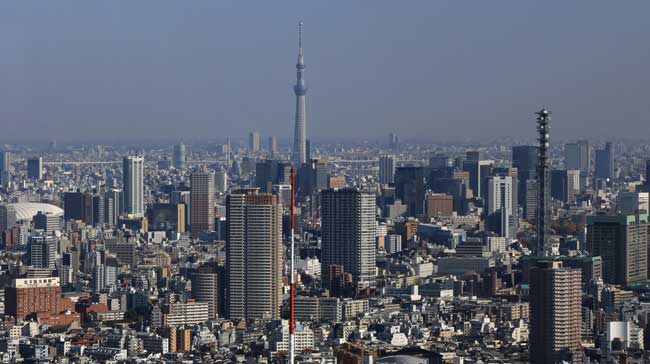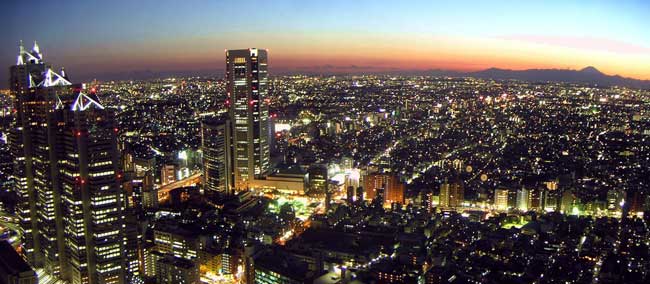
Travel Guide
Introduction
The Tokyo Metropolitan Government Building, "Tocho" for short or “City Hall”, is one of Tokyo’s landmarks and is often visited by tourists for its free observation decks. There are windows all around the observatory floor, makes it provide one of the best views both in day time and night in all of Tokyo.
The Tokyo Metropolitan Government Buildinghouses the headquarters of the Tokyo Metropolitan Government, which governs not only the 23 wards, but also the cities, towns and villages that make up Tokyo as a whole.
There are two panoramic observation decks, North Observatory and South Observatory, in Tokyo Metropolitan Main building No.1 which has two towers. One observatory in each tower on floor 45 (202 meters [663 ft] high), are free of charge to the public. With favorable weather conditions, famous landmarks such as Mount Fuji, the Tokyo Skytree, Tokyo Tower, Meiji Shrine and the Tokyo Dome can be seen from the observatories. Each observatory has a cafe and a souvenir shop. The North Observatory remains open later at night, making it a popular spot to catch night views of the city. The towers and the surrounding buildings contain the offices and the assembly hall of the metropolitan government of Tokyo. Visitors are therefore subjected to bag checks prior to boarding the elevators as part of the security measures.
On the second story of the building, there is a tourist information center with lots of information about Tokyo in many languages, but also about various other tourist destinations across Japan.

Structure
The building consists of a complex of three structures, each taking up a city block. The tallest and most prominent of the three is Tokyo Metropolitan Main building No.1, a tower 48 stories tall that splits into two sections at the 33rd floor. Observatories are located in this building. The building also has three levels below ground. The design of the building (which was meant to resemble a computer chip) has many symbolic touches, most notably the aforementioned split which re-creates the look of a Gothic cathedral.
The other two buildings in the complex are the eight-story Tokyo Metropolitan Assembly Building (including one underground floor) and Tokyo Metropolitan Main Building No.2, which has 37 stories including three below ground.

History
The building was designed by Kenzo Tange and finished in December 1990 at the expense of ¥157 billion (about US$ 1 billion) of public money. It replaced the former Tokyo City Hall at Yurakucho, which was built in 1957 and also design by Tange. The former Tokyo City Hall is now the site of the Tokyo International Forum.
It was the tallest building (by roof height) in Tokyo, at 243 meters [797 ft], until the Midtown Tower was completed in 2006.
Though it has not gained the same degree of worldwide recognition as Tokyo Tower or Tokyo Skytree, the Metropolitan Government Building has come to represent the city in its own right. It frequently appears in Japanese science fiction as a symbol of authority or in type scenes depicting a futuristic or post-apocalyptic Shinjuku.
Travel Advice
Observatory
Hours:
North Observatory: 9:30 to 23:00
South Observatory: 9:30 to 17:30 (until 23:00 when North Observatory is closed)
Admission end 30 minutes before closing time
Closed:
North Observatory: 2nd and 4th Monday of each month (next day if national holiday)
South Observatory: 1st and 3rd Tuesday of each month (next day if national holiday)
Both observatories: December 29 to January 3 (except January 1)
Visit
| Address | 2-8-1 Nishi-shinjuku, Shinjuku-ku, Tokyo | |
| Phone | 03-5321-1111 | |
| Admission | Free | |
| Hours | 08:00 to 18:45 Main building No.1 and No.2 08:00 to 18:00 City Hall of Tokyo Metropolitan Assembly |
|
| Closed | Weekend and National Holidays | |
| Duration | 20 minutes | |
| Getting There | By Train 5 minutes walk from Tochomae Station on subway Oedo Line. 10 minutes walk from Shinjuku Station on JR Yamanote Line, JR Saikyo Line, JR Chuo Line, JR Somu Line, Keio Line, subway Ginza Line, subway Marunouchi Line or subway Oedo Line. |
|
| Parking | Paid parking available | |

